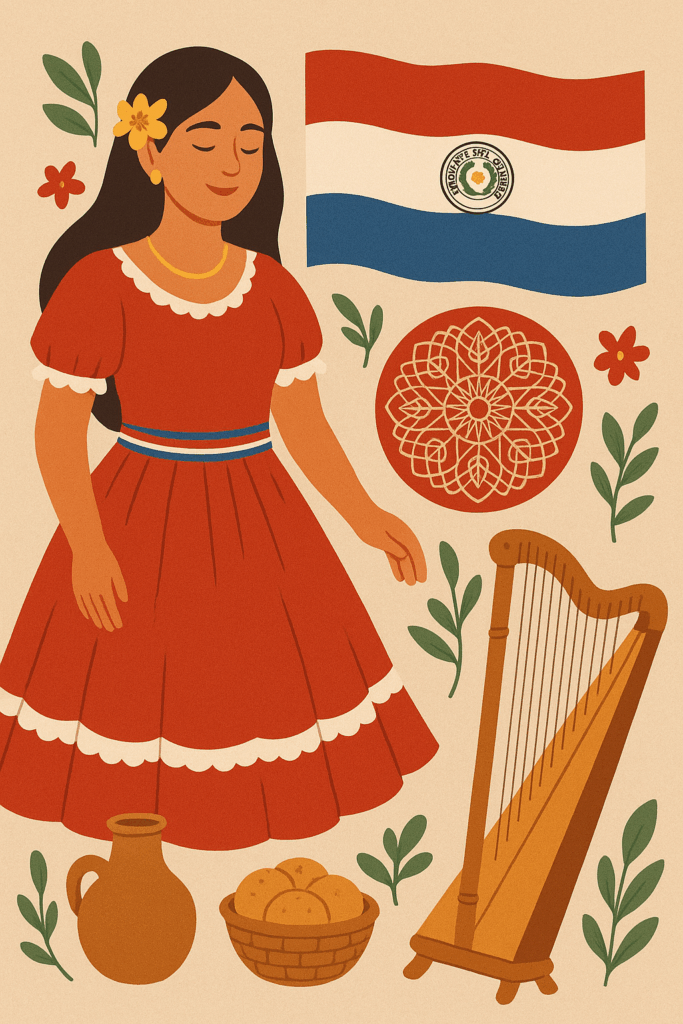Paraguay is a country full of curiosities, surprises, and cultural quirks that even many visitors or outsiders rarely notice. Beyond the well-known facts about hydroelectric power and agriculture, there are even more details about its language, lifestyle, nature, and traditions.
1. Unique National Emblem
Paraguay is the only country in the world whose national flag has different symbols on the front and back: the state coat of arms on one side, and the seal of the Ministry of Finance on the other.
2. Tereré The Social Drink
The cold mate drink “Tereré” is not just popular; it is an official cultural heritage of Paraguay. It is often shared in a communal round from the same guampa (gourd) with a bombilla (metal straw), symbolizing friendship and equality.
3. Bilingual Everyday Culture
Over 80% of the population speaks Spanish and Guaraní simultaneously. This unique language blend, known as “Jopará,” shapes daily communication and is found nowhere else in the world.
4. The Vast Gran Chaco
The Gran Chaco covers 60% of Paraguay’s land area but is home to only about 3% of the population. This hot and wild region hosts many Mennonite colonies engaged in agriculture and livestock farming.
5. Ñandutí Spider Web Art
The traditional lacework “Ñandutí” is inspired by spider webs. Each handcrafted piece is unique, often reflecting natural patterns or local legends.
6. Historical Pioneer
Before the Triple Alliance War (1864–1870), Paraguay had free education, railways, and its own industry and no foreign debt. After the war, over 60% of the population was lost.
7. Ice as a Luxury in Rural Areas
In many rural regions without electricity, ice is a luxury. It is bought from the city and insulated with blankets to keep drinks cool.
8. Right Hand Drive Cars
Many vehicles are right-hand drive imports from Japan, even though Paraguay drives on the right side of the road. This is technically illegal but very common.
9. More Cattle Than People
With 14 million cattle and 7 million people, livestock dominates rural areas and is a key export sector.
10. The Paraguayan Harp
The “arpa paraguaya” is smaller and lighter than classical harps but highly virtuosic. It is a national symbol played at concerts, celebrations, and even pop performances.
11. Paraguay A Green Country
Over 40% of the country is covered in forests, many of them untouched. Paraguay has one of the highest forest coverage rates in South America.
12. High Egg Production
Paraguay is one of the largest egg producers in Latin America per capita, thanks to modern poultry systems.
13. Abundant Water Resources
Besides the Paraná and Paraguay rivers, the country sits atop the Guaraní Aquifer System, one of the largest groundwater reservoirs in the world.
14. Rich Biodiversity
Paraguay hosts over 700 bird species, including toucans, exotic parrots, and many endemic species.
15. Carnival Local and Colorful
The “Carnaval Encarnaceno” is especially colorful, less commercialized, and heavily inspired by Guaraní culture.
16. Guaraní in Politics
Politicians often speak Guaraní in official speeches, demonstrating the deep integration of the language into public life.
17. Curious Eating Habits
The “Sopa paraguaya” sounds like a soup, but it is a dense corn and cheese casserole. Meat and corn dominate the diet, often combined with herbs and chili.
18. Boats as a Daily Means of Transport
In rural regions of the Chaco or along rivers, boats are often the main form of transport, especially during the rainy season when roads are impassable.
19. High Literacy Rate
Paraguay achieves a literacy rate of over 94%, thanks in part to early school enrollment and bilingual education.
20. Family and Community Culture
Many Paraguayans live in close knit family units, often across generations, which strongly shapes social life.
Conclusion
Paraguay continually surprises with its unique quirks, traditions, and cultural features. Understanding these is essential to truly appreciate and better understand the Paraguayan people, providing a deeper insight into this distinctive country.
